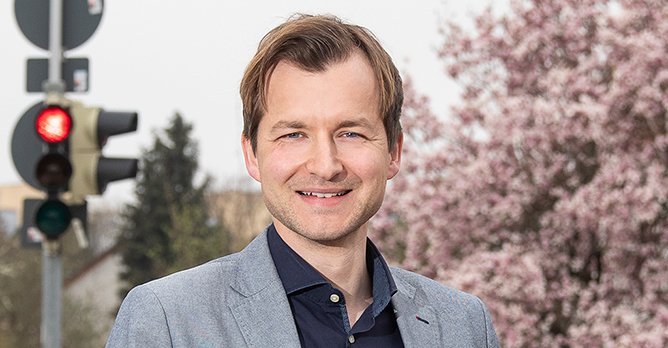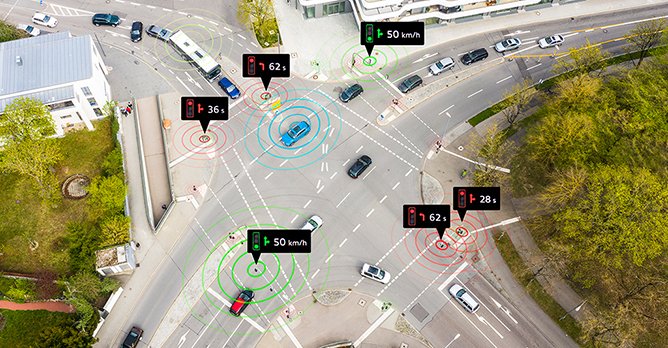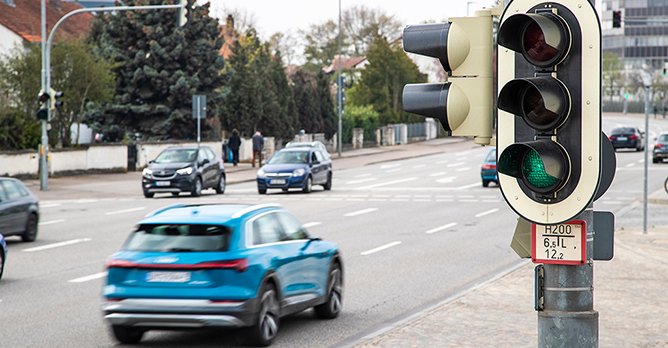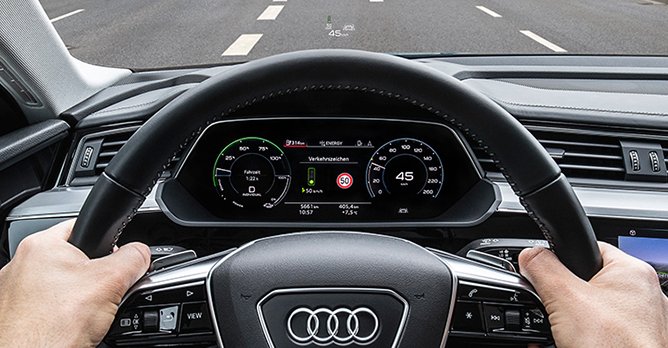Audi networks with traffic lights in Europe
17 May 2019|2,493 views
Audi is introducing the vehicle-to-infrastructure (V2I) service 'Traffic Light Information' to Europe. Audi drivers will see in the cockpit what speed is required to reach the next traffic light on green. If that is not possible within the permitted speed limit, there will be a countdown to the next green phase. Driving in cities will thus become more relaxed and efficient. Audi is the first manufacturer worldwide to network its series-production models with traffic lights in cities.

In the U.S.A, Audi customers have been using the 'Time-to-Green' function for two years: If the driver will reach the lights on red, a countdown in the Audi virtual cockpit or head-up display counts the seconds to the next green phase.
This service is now available at more than 5,000 intersections in the U.S.A, for example in cities including Denver, Houston, Las Vegas, Los Angeles, Portland and Washington D.C. In the U.S capital alone, about 1,000 intersections are linked to the Traffic Light Information function.
Since February, Audi has offered a further function in North America. The purpose of this is especially to enable driving on the 'green wave'. 'Green Light Optimized Speed Advisory' (GLOSA) shows to the driver in the ideal speed for reaching the next traffic light on green.
Both Time-to-Green and GLOSA will be activated for the start of operation in Ingolstadt in selected Audi models. These include all Audi e-tron models and the A4, A6, A7, A8, Q3, Q7 and Q8 to be produced from mid-July ('model year 2020').
The prerequisite is the 'Audi connect Navigation & Infotainment' package and the optional 'camera-based traffic sign recognition'.
Audi is working to offer Traffic Light Information in further cities in Germany, Europe, Canada and the U.S.A in the coming years. In the large east Chinese city of Wuxi, Audi and partners are testing networks between cars and traffic light systems in the context of a development project.
In future, Audi customers may be able to benefit from additional functions, for example when 'green waves' are incorporated into the ideal route planning. It is also conceivable that Audi e-tron models, when cruising up to a red traffic light, will make increased used of braking energy in order to charge their batteries. Coupled with predictive adaptive cruise control (pACC), the cars could even brake automatically at red lights.
In the long term, urban traffic will benefit. When cars send anonymised data to the city, for example, traffic signals could operate more flexibly. Every driver knows the following situation: In the evening you wait at a red light - while no other car is to be seen far and wide. Networked traffic lights would then react according to demand.
Drivers of other automotive brands will also profit from the development work that Audi is carrying out with Traffic Light Information - good news for cities, which are dependent on the anonymised data of large fleets to achieve the most efficient traffic management.
In future, V2I technologies like Traffic Light Information will facilitate automated driving. "A city is one of the most complex environments for an autonomous car. Nevertheless, the vehicle has to be able to handle the situation, even in rain and snow. Data exchange with the traffic infrastructure can be highly relevant here," says Hainzlmaier.
Audi is introducing the vehicle-to-infrastructure (V2I) service 'Traffic Light Information' to Europe. Audi drivers will see in the cockpit what speed is required to reach the next traffic light on green. If that is not possible within the permitted speed limit, there will be a countdown to the next green phase. Driving in cities will thus become more relaxed and efficient. Audi is the first manufacturer worldwide to network its series-production models with traffic lights in cities.

In the U.S.A, Audi customers have been using the 'Time-to-Green' function for two years: If the driver will reach the lights on red, a countdown in the Audi virtual cockpit or head-up display counts the seconds to the next green phase.
This service is now available at more than 5,000 intersections in the U.S.A, for example in cities including Denver, Houston, Las Vegas, Los Angeles, Portland and Washington D.C. In the U.S capital alone, about 1,000 intersections are linked to the Traffic Light Information function.
Since February, Audi has offered a further function in North America. The purpose of this is especially to enable driving on the 'green wave'. 'Green Light Optimized Speed Advisory' (GLOSA) shows to the driver in the ideal speed for reaching the next traffic light on green.
Both Time-to-Green and GLOSA will be activated for the start of operation in Ingolstadt in selected Audi models. These include all Audi e-tron models and the A4, A6, A7, A8, Q3, Q7 and Q8 to be produced from mid-July ('model year 2020').
The prerequisite is the 'Audi connect Navigation & Infotainment' package and the optional 'camera-based traffic sign recognition'.
Audi is working to offer Traffic Light Information in further cities in Germany, Europe, Canada and the U.S.A in the coming years. In the large east Chinese city of Wuxi, Audi and partners are testing networks between cars and traffic light systems in the context of a development project.
In future, Audi customers may be able to benefit from additional functions, for example when 'green waves' are incorporated into the ideal route planning. It is also conceivable that Audi e-tron models, when cruising up to a red traffic light, will make increased used of braking energy in order to charge their batteries. Coupled with predictive adaptive cruise control (pACC), the cars could even brake automatically at red lights.
In the long term, urban traffic will benefit. When cars send anonymised data to the city, for example, traffic signals could operate more flexibly. Every driver knows the following situation: In the evening you wait at a red light - while no other car is to be seen far and wide. Networked traffic lights would then react according to demand.
Drivers of other automotive brands will also profit from the development work that Audi is carrying out with Traffic Light Information - good news for cities, which are dependent on the anonymised data of large fleets to achieve the most efficient traffic management.
In future, V2I technologies like Traffic Light Information will facilitate automated driving. "A city is one of the most complex environments for an autonomous car. Nevertheless, the vehicle has to be able to handle the situation, even in rain and snow. Data exchange with the traffic infrastructure can be highly relevant here," says Hainzlmaier.
Latest COE Prices
June 2025 | 2nd BIDDING
NEXT TENDER: 09 Jul 2025
CAT A$98,124
CAT B$116,670
CAT C$65,000
CAT E$116,889
View Full Results Thank You For Your Subscription.































